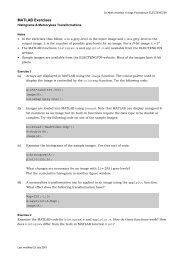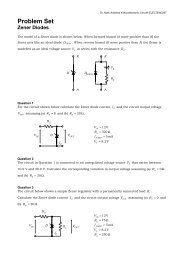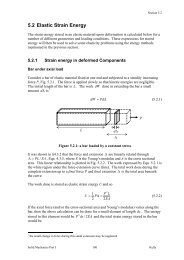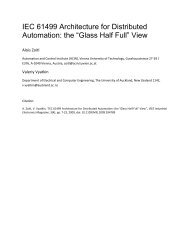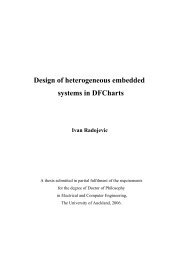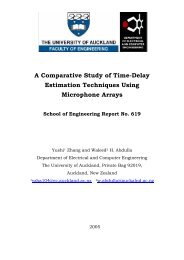Formal description of IEC 61499 control logic with - The University of ...
Formal description of IEC 61499 control logic with - The University of ...
Formal description of IEC 61499 control logic with - The University of ...
Create successful ePaper yourself
Turn your PDF publications into a flip-book with our unique Google optimized e-Paper software.
Execution time <strong>of</strong> a branching path<br />
tpath_br<br />
Table 1: Parameters for static analysis <strong>of</strong> event propagation <strong>with</strong>in the<br />
C++FBRT<br />
IV. FORMAL DESCRIPTION OF THE C++ FBRT<br />
<strong>The</strong> C++FBRT is modeled by use <strong>of</strong> Net<br />
Condition/Event Systems (NCES). A brief overview <strong>of</strong><br />
NCES is available in Vyaktin [16].<br />
Description <strong>of</strong> the modeling <strong>of</strong> the Queue <strong>with</strong>in the<br />
event dispatcher for 3 events and 5 places (including a<br />
figure)<br />
• What happens during registration to the event<br />
dispatcher<br />
• What happens during fetching from the event<br />
dispatcher<br />
Description <strong>of</strong> the model for a list <strong>of</strong> connected FBs<br />
<strong>with</strong>in an output event. (figure ?)<br />
Description <strong>of</strong> the operation <strong>of</strong> the C++FBRT, the<br />
“<strong>control</strong>” model always fetching events (figure ?)<br />
Description <strong>of</strong> the Timing interfaces <strong>with</strong>in the<br />
C++FBRT (including a figure)<br />
• Mutual exclusion for access to the event<br />
dispatcher<br />
A. Implementation <strong>of</strong> physical time in the NCES models<br />
Interruption <strong>of</strong> the operation <strong>of</strong> a NCES-model<br />
• General behavior <strong>of</strong> NCES – doing things in<br />
steps (Is [16] sufficient as reference for that?)<br />
• Use a special condition for the sake <strong>of</strong> blocking<br />
execution (connected to all transitions <strong>with</strong>in<br />
the relevant part <strong>of</strong> the model)<br />
• Blocking <strong>of</strong> timed conditions (including a<br />
figure)<br />
V. COMPARISON OF RESULTS<br />
According to the methologies presented in this paper, we<br />
have compared our approaches by use <strong>of</strong> a simple function<br />
block network depicted in Figure 3. <strong>The</strong> test environment<br />
was a Infineon C167CS micro<strong>control</strong>ler (µC), mounted on<br />
a development board phyCORE-167-HS/E. This simple 16<br />
bit µC is sufficient to execute the C++FBRT. More details<br />
about the µC as well as the measurement procedure can be<br />
found in R<strong>of</strong>ner [15].<br />
This example can be analyzed by three different test<br />
cases. <strong>The</strong> first one (TC 1) is direct measurement <strong>of</strong> the<br />
execution behavior <strong>of</strong> the overall runtime environment.<br />
<strong>The</strong>refore the method <strong>of</strong> setting and reseting Boolean<br />
outputs is used, the measurements can be applied by use <strong>of</strong><br />
a digital oscilloscope. You can find our results concerning<br />
to this test case in Table 3 <strong>with</strong>in the second column.<br />
<strong>The</strong> second test case (TC 2) consists <strong>of</strong> the measurement<br />
<strong>of</strong> the parameters defined in Table 1 and applying the<br />
method <strong>of</strong> static timing analysis. <strong>The</strong> results <strong>of</strong> this method<br />
are presented in Table 3, third column. To give an example<br />
for the calculation <strong>of</strong> these results, we provide the<br />
algorithm for the measurement from the fetching <strong>of</strong> event<br />
Clock.EO to the finishing <strong>of</strong> the execution <strong>of</strong> FB3. <strong>The</strong><br />
values <strong>of</strong> the parameters for the test environment are<br />
presented in Table 2. <strong>The</strong> formula for the calculation <strong>of</strong> the<br />
mentioned execution path is mentioned in (4).<br />
Parameter Value for test environment<br />
tFB<br />
15,45 µs (for instances <strong>of</strong> simpleFB)<br />
tWs<br />
31,34 µs<br />
tWbr<br />
25,91 µs<br />
1,35 µs<br />
tEv<br />
Table 2: Time values for the parameters from the test environment<br />
???? (4)<br />
Description <strong>of</strong> formula (4).<br />
Figure 3: Example Function Block Network<br />
<strong>The</strong> third test case (TC 3) is the formal verification <strong>of</strong><br />
this example and extraction <strong>of</strong> the timing information from<br />
the possible paths <strong>with</strong>in the state space <strong>of</strong> this system. <strong>The</strong><br />
system that is modeled consists <strong>of</strong> the µC (timing interrupt<br />
and physical execution time), the C++FBRT and the<br />
application depicted in Figure 3. <strong>The</strong> verification is<br />
provided by the tool iMATCh (Integrated Model<br />
Assembler Translator and Checker) from Valeriy Vyaktin.<br />
A brief <strong>description</strong> <strong>of</strong> the tool is available in [3].<br />
Description <strong>of</strong> the state space <strong>of</strong> the system and the<br />
extraction <strong>of</strong> the timing information from the model<br />
checker.<br />
End point TC 1 TC 2 TC 3<br />
FB3<br />
finished<br />
137,79 µs 137,64 µs ?<br />
FB4<br />
finished<br />
181,79 µs 181,7 µs ?




